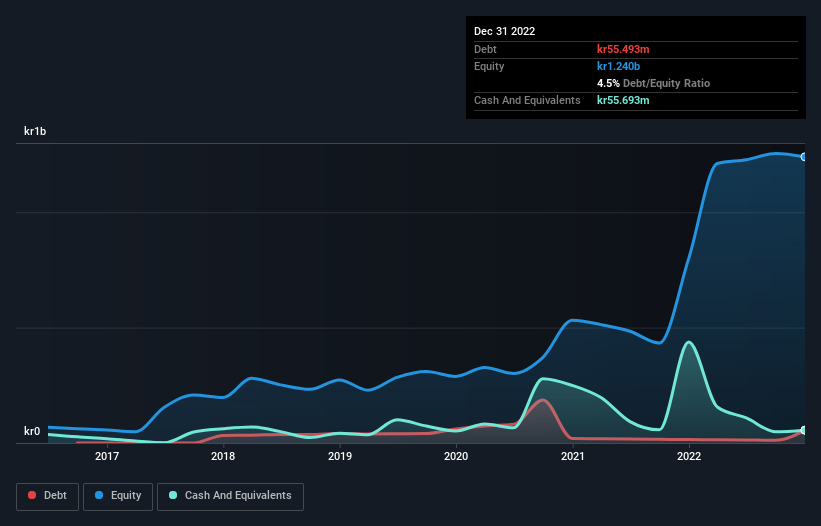Some say volatility, rather than debt, is the best way to think about risk as an investor, but Warren Buffett famously said that 'Volatility is far from synonymous with risk.' So it seems the smart money knows that debt - which is usually involved in bankruptcies - is a very important factor, when you assess how risky a company is. We note that Sivers Semiconductors AB (publ) (STO:SIVE) does have debt on its balance sheet. But should shareholders be worried about its use of debt?
When Is Debt A Problem?
Debt and other liabilities become risky for a business when it cannot easily fulfill those obligations, either with free cash flow or by raising capital at an attractive price. Ultimately, if the company can't fulfill its legal obligations to repay debt, shareholders could walk away with nothing. While that is not too common, we often do see indebted companies permanently diluting shareholders because lenders force them to raise capital at a distressed price. Of course, debt can be an important tool in businesses, particularly capital heavy businesses. The first thing to do when considering how much debt a business uses is to look at its cash and debt together.
View our latest analysis for Sivers Semiconductors
How Much Debt Does Sivers Semiconductors Carry?
The image below, which you can click on for greater detail, shows that at December 2022 Sivers Semiconductors had debt of kr55.5m, up from kr15.0m in one year. But on the other hand it also has kr55.7m in cash, leading to a kr200.0k net cash position.

How Healthy Is Sivers Semiconductors' Balance Sheet?
The latest balance sheet data shows that Sivers Semiconductors had liabilities of kr141.0m due within a year, and liabilities of kr190.1m falling due after that. Offsetting this, it had kr55.7m in cash and kr58.1m in receivables that were due within 12 months. So it has liabilities totalling kr217.2m more than its cash and near-term receivables, combined.
Since publicly traded Sivers Semiconductors shares are worth a total of kr1.68b, it seems unlikely that this level of liabilities would be a major threat. But there are sufficient liabilities that we would certainly recommend shareholders continue to monitor the balance sheet, going forward. Despite its noteworthy liabilities, Sivers Semiconductors boasts net cash, so it's fair to say it does not have a heavy debt load! There's no doubt that we learn most about debt from the balance sheet. But it is future earnings, more than anything, that will determine Sivers Semiconductors's ability to maintain a healthy balance sheet going forward. So if you're focused on the future you can check out this free report showing analyst profit forecasts.
In the last year Sivers Semiconductors wasn't profitable at an EBIT level, but managed to grow its revenue by 30%, to kr192m. Shareholders probably have their fingers crossed that it can grow its way to profits.
So How Risky Is Sivers Semiconductors?
By their very nature companies that are losing money are more risky than those with a long history of profitability. And in the last year Sivers Semiconductors had an earnings before interest and tax (EBIT) loss, truth be told. And over the same period it saw negative free cash outflow of kr222m and booked a kr86m accounting loss. With only kr200.0k on the balance sheet, it would appear that its going to need to raise capital again soon. With very solid revenue growth in the last year, Sivers Semiconductors may be on a path to profitability. By investing before those profits, shareholders take on more risk in the hope of bigger rewards. The balance sheet is clearly the area to focus on when you are analysing debt. However, not all investment risk resides within the balance sheet - far from it. These risks can be hard to spot. Every company has them, and we've spotted 4 warning signs for Sivers Semiconductors (of which 1 is significant!) you should know about.
If, after all that, you're more interested in a fast growing company with a rock-solid balance sheet, then check out our list of net cash growth stocks without delay.
New: Manage All Your Stock Portfolios in One Place
We've created the ultimate portfolio companion for stock investors, and it's free.
• Connect an unlimited number of Portfolios and see your total in one currency
• Be alerted to new Warning Signs or Risks via email or mobile
• Track the Fair Value of your stocks
Have feedback on this article? Concerned about the content? Get in touch with us directly. Alternatively, email editorial-team (at) simplywallst.com.
This article by Simply Wall St is general in nature. We provide commentary based on historical data and analyst forecasts only using an unbiased methodology and our articles are not intended to be financial advice. It does not constitute a recommendation to buy or sell any stock, and does not take account of your objectives, or your financial situation. We aim to bring you long-term focused analysis driven by fundamental data. Note that our analysis may not factor in the latest price-sensitive company announcements or qualitative material. Simply Wall St has no position in any stocks mentioned.
About OM:SIVE
Sivers Semiconductors
Through its subsidiaries, develops, manufactures, and sells chips, components, modules, and subsystems in North America, Europe, and Asia.
Good value with adequate balance sheet.
Market Insights
Community Narratives



